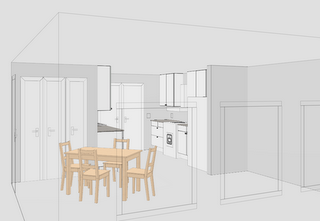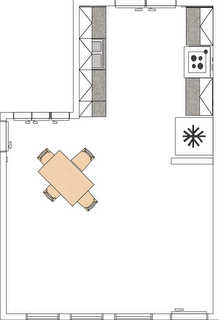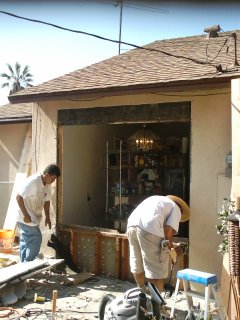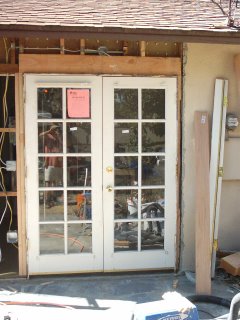This blog post was updated in October, 2009.
See also
http://bammorgan.blogspot.com/2008/04/directory-of-salvage-yards.htmlI first made this list when I was having trouble finding information on salvage yards. The latest update was about 2005. I've not verified all of them.
Construction and Architectural Salvage - San Diego to Los Angeles Counties
June 20, 2005
Salvage yards seem to have a very low profile on the web.
---San Diego---
Architectural Salvage of San Diego2401 Kettner Blvd, San Diego, CA 92101
Categories: Antique & Used Architectural Building Materials
EPFO (aka Antique Building Materials)
6152 Wenrich Drive
San Diego, CA 92120
(619) 583-3791
(619) 583-9087 (fax)
http://ancientarchitecture.com/epfo.htm
Comment: appears high end, imported - BAM
Builders Trading Company90 N Coast Highway 101
Encinitas, CA 92024
(760) 634-3220
http://www.builderstrading.com/
Vintage Architectural
1861 Main Street Suite B, San Diego, CA 92113
(619) 239-7636
Website http://www.vintagearchitectural.com
Categories: Antique & Used Architectural Building Materials
Comments: Home page not easily found on the web. Is it defunct? -BAM 11-2008
Pacific Wholesale Materials
8910 Activity Road, Suite D, San Diego, CA Phone
619-653-0411 Fax
619-653-0412
Comments: probably just resawn lumber, but I could be wrong. -BAM
---Orange---
Tony's Architectural Salvage
123 N. Olive
Orange CA 92866
714.538.1900 714.538.1966 (Fax)
www.tonysarchitecturalsalvage.com/homepage.htm
Located in Historic Old Towne Orange
55 Freeway - Exit Chapman, go West on Chapman. Proceed around Plaza Circle. Turn Right at Olive.
57 Freeway - Exit Chapman (Orange) proceed East to Olive. Left at Olive.
Was there in 2003 and thought things waaay overpriced, but good quality. BAM
---Los Angeles---
LIZ'S ANTIQUE HARDWARE453 South La Brea
Los Angeles, Ca 90036
323-939-4403
lahardware.com
Comment: as it says in the name - hardware (no doors, etc) -BAM
Architectural Detail2449 White Street
Pasadena, CA 91107
Tel: 626 844-6670
Comment: ONLINE ONLY. Resource for restorationists consisting of locally salvaged items from the turn of the 19th century to 1960. Stock assorted hardware, doors, windows, lumber, flooring, old glass, bathroom fixtures and accessories, bricks, and roof tiles. Currently occupying 45,000 sq. ft. with recent acquisition of Manchester Sash and Door.
www.vintageplumbing.commailing address:
9645 Sylvia Avenue
Northridge, CA 91324
818-772-1721
Comment: ONLINE ONLY. "Local buyers may visit the warehouse to pick up what they purchase from us, but most everything we sell is shipped out of the local area. There are many items in the warehouse that are not for sale, and everything is jam packed and jumbled making it impossible to open the warehouse for lookers. Tell us by email what you are looking for, and we will reply with photos and description if we have it. Antique Stoves10826 Venice Blvd., #108
Culver City
(310) 287-1910
www.antiquestove.com
Big Ten Building Materials & Supplies
757 W. Wood
Altadena, CA 91001
New number (2009) is 626-437-6656
From 210 e. exit winsor go left.
Comment: Sells doors, windows, hardware. Must make an appointment. Unable to easily locate a web page.
Square Deal Plumbing Supplies2302 E. Florence Ave.
Huntington Park
(323) 587-8291
Comment: Bathtub and toilet fixtures; retrofit old salvaged pieces. ..."Hard to find vintage fixtures and hardware [and] knowledge of how to repair your vintage bathroom fixtures."
Carlos Antique Hardware & Locksmith620 S. La Brea
Los Angeles
(323) 954-1717
Comment: great collection of old door hardware; repairs
Crown City Hardware Company1047 North Allen Avenue
Pasadena, California
91104
626-794-1188
213-684-1515
Mead House Wrecking Co
Pasadena
(626) 796-4051
Comment: sounds like they just do demolition
RWH Construction Salvage
12722 Carmenita Rd.
Santa Fe Springs CA 90670
(562) 698-7250
Comment: Architectural salvage yard? Looks more like architectural deconstruction.-BAM 11-2008
San Gabriel Valley Habitat For Humanity
(626) 792-3838
770 N Fair Oaks Ave Pasadena
Scavenger's Paradise
5453 Satsuma Ave
North Hollywood, CA 91602.
323 877 7945
Have heard good things about this one -BAM
Molina and Son
213-626-4770
1210 E 5th St
Los Angeles
Comment: from a note paper scrap. no yellow pages or web info -BAM
The Reuse People888-588-9490
www.TheReusePeople.org
Comment: Bay area based, but LA area partners w/ Habitat for Humanity Gardena and Silverlake yards -BAM
Silverlake Yards:
1086 Manzanita Street
Silver Lake, CA 90026
(323) 667-2875
Hours: Friday, Saturday & Sunday 10 a.m. to 4 p.m. by appointment (only? -BAM). Directions: Manzanita Street crosses Sunset Boulevard in Silver Lake. Go south 1 short block and turn right just before Santa Monica Boulevard.
Olde Good Things1800 South Grand Avenue
Los Angeles, CA 90015
213-746-8600 or 8611
213-210-7675 cell
http://www.ogtstore.com/
http://www.oldegoodthings.com/
Comment: Appointments only? Looks to be high end and trade only. Presence at SM, Rose Bowl, LB flea markets -BAM
European Reclamation4524 Brazil St, Los Angeles, California
818 241 2152 Fax 818 547 2734
http://www.historictile.com/reclaim.html
Comment: no doors on the web site - stone, iron, tile only.
Santa Fe Wrecking Company1600 South Santa Fe Avenue
Los Angeles, California 90021
213.623.3119
http://santafesalvage.net/
8:00 AM - 5:00 PM Monday-Friday
8:00 AM - 3:00 PM Saturdays
9:30 AM - 3:00 PM Sundays
Comment: Was there in 2003 - many doors, but seemed overall poor quality. -BAM
Habitat for Humanity
17700 South Figueroa St.
Gardena, CA 90248
http://www.shophabitat.org/
Tues. - Sat. / 9am -6pm
Comment:
--LA Flea Markets and person to person--
http://losangeles.craigslist.org/
Santa Monica Outdoor Antique & Collectible Market (4th Sunday of the month -- $7 early admission from 6am-8am. Otherwise $5 general admission, seniors $3, kids and dogs free)
and
Westside Antique Show (smaller show, 1st Sunday of the month 8:30am--3pm. Admission is $4.)
Airport Ave off of Bundy
Los Angeles, CA 90405
(323) 933-2511
Rosebowl Flea Market at the famous Rose Bowl Stadium in Pasedena, CA
The second Sunday of every month
Long Beach Outdoor Antique and Collectible Market, held 5:30 a.m. to 3 p.m. every third Sunday of the month at Veterans Memorial Stadium
The Grove Antique Market at Irvine Valley College, 7 a.m. to 2 p.m. on the first Sunday of the month, (949) 786-5277
Supplementary addition Oct, 2009
The LA Times has a list of Do-it-yourself salvage and supply houses in their Home section today.
The article is titled, "Helpful sites and stores for a home redo" and is located
here.
In case the link changes, I'll repeat the article here.
The Home staff has culled recommendations from the architects, interior designers and do-it-yourselfers featured in this section to compile this list of resources for anyone planning to remodel, redecorate or otherwise turn his or her home into a work in progress. A sampling of stores and expert advice you might find helpful:
Decorating
Fashion District in downtown Los Angeles, the vicinity of 9th and Wall streets, for curtain and drapery fabric.
www.ichiroya.com for Japanese bedding, including futon covers that can be used as bedspreads.
Restoration Hardware Furniture Outlet in Camarillo, (805) 445-7707, for drawer pulls.
Carter Hardware in Beverly Hills, (310) 657-1940, for bronze door hardware.
www.rejuvenation.com for curtain rods and rings.
www.surfaceview.co.uk for murals and oversize artwork, including licensed reproductions from Victoria & Albert Museum and other British art institutions.
Portola Paints and Glazes in Studio City, www.portolapaints.com, for textural paints and lime washes.
Building materials
Metal Window Corp. in Inglewood, www.metalwindowcorp.com, for aluminum windows.
Hermosa Terrazzo in Hermosa Beach, www.hermosati.com, for terrazzo flooring installed on-site.
Anderson Plywood in Culver City, www.andersonplywood.com, for decorative plywood used to make furniture.
Culver City Industrial Hardware, www.culverhardware.com, for rubber furniture wheels.
Tile, flooring
Linoleum City in Hollywood, www.linoleumcity.com, for cork tile.
Orange County Tile in Anaheim, www.orangecountytileco.com, for Mexican Talavera tile.
West Los Angeles Building Materials, www.wlabm.com, for stone flooring.
B&W Tile in Gardena, www.bwtile.com, for affordable floor and wall coverings.
Mortarless Building Supply in Los Angeles, (323) 663-3291, for Mexican tile.
United Team Tile & Stone in Los Angeles, (323) 257-8181, for affordable selections.
Classic Tile & Mosaic in Los Angeles, www.ctandm.com, for its clearance room.
Lighting
Pasadena Antique Center and Annex, www.pasadenaantiquecenter.com, for the old look.
www.2modern.com for a modern look.
IKEA, www.ikea.com, for pendant lights (textiles and kitchen cabinetry too).
Rewire in L.A., www.rewirela.com, for vintage.
Rugs
Bobcat Carpet & Fabric Care in West L.A., www.bobcatcarpetcare.com, for binding carpet remnants into area rugs.
Eastern Oriental Rugs in Pasadena, www.easternorientalrugs.com, for the vintage rugs in the back of the store.
Entertaining
Bar Keeper in Silver Lake, www.barkeepersilverlake.com, for cocktail glasses and other retro barware.
Big Lots, www.biglots.com, for basic utensils, glassware and solid-color dishes. (Thank you, Philippe Starck, for the recommendation.)
Cost Plus World Market for beachy rugs, throw blankets and lanterns. (Thank you, Kelly Wearstler.)
Oceanic Arts in Whittier, www.oceanicarts.net, for tiki paraphernalia.
Outdoor decor
www.partylights.com for overhead carnival-style string lights.
California Cactus Center in Pasadena, www.cactuscenter.com, for unusual varieties.
California Nursery Specialties Cactus Ranch in Reseda, www.california-cactus-succulents.com, for more low-water plants (specializes in commercial projects but opens to the public on weekends).
Bourget Brothers in Santa Monica, www.bourgetbros.com, and Sunburst Decorative Rock in Irwindale, www.sunburstrock.com, for decorative garden ground cover.
Rolling Greens nursery in Culver City, www.rollinggreensnursery.com, for oversized pots and realistic-looking artificial plants.
Yan's Gifts & Souvenirs in downtown Los Angeles, (213) 680-3078, for outdoor mats and bamboo umbrellas.
Architectural salvage
Olde Good Things in L.A., www.oldegoodthings.com.
Pasadena Architectural Salvage, www.pasadenaarchitecturalsalvage.com.
Silverlake Architectural Salvage in L.A., www.silverlakearchitecturalsalvage.net.
Vintage
The Huntington Collection in Pasadena, www.thehuntingtoncollection.com, for the last-Saturday-of-the-month sale.
Furniture House L.A., (323) 461-4703, for retro cabinetry and upholstered furniture.
Retropia in Los Angeles, www.retropia.net, for 1950s and '60s decor.
Floor-Model, www.floor-model.com, for its North Hollywood warehouse's Danish modern bookcases, consoles, tables.
Don & Dee's Old California Store in Ventura, (805) 643-4217.
Thrift stores
St. Vincent de Paul in Los Angeles (also in Oxnard and Long Beach), www.svdpla.org.
Out of the Closet in Tarzana (yes, specifically Tarzana), www.outofthecloset.org.
Council Thrift Store in Los Angeles, www.councilthrift.org.
Miscellaneous
Advanced Liquidators in North Hollywood, www.advancedliquidators.com, for new and used office furniture.
Alaco Ladder Co. in Chino, (909) 591-7561, for rolling library ladders that make high shelves more functional.
Felt Club, the annual L.A. show for handmade crafts, to be held Nov. 16 at the Shrine Auditorium Expo Center.









